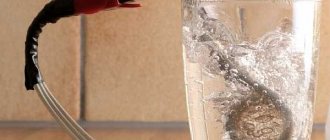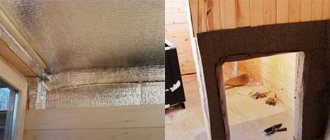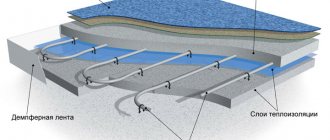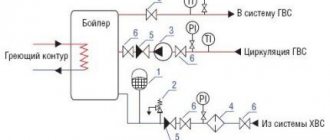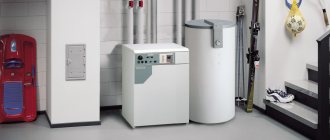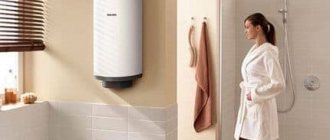Today, most of the family budget goes to paying for consumed heat. The further you go, the more expensive it becomes to heat your home. If you want to save money and control your heat costs, there is a way out. To do this you need to buy a heat meter. This device is designed to accurately account for energy costs for heating your home or apartment. Statistics show that correct installation of the meter will reduce heating bills by 25–50%. It all depends on the building where it will be located. Let's look at how the device works, its operating principle, types and how to install a heat meter.
Advantages of devices
In addition to the fact that installing individual heat meters in an apartment allows you to make payments depending on the readings, it undoubtedly has other advantages.
Heat meters for apartments
These characteristic advantages include:
- Private meter installations in a residential area allow you to regulate energy consumption depending on weather conditions. This is mainly in demand during the spring and autumn periods, when the temperature outside can change every day.
- Using the device, you can detect malfunctions in the coolant line (air pockets, blockages). This leads to an uneven supply of heat, which, of course, will immediately appear on the meter readings in the apartment.
- The installation of individual heat meters is also necessary because utility organizations calculate heating fees according to established standards, and not based on actual consumption. With the device, every month the heat in the apartment will be metered according to the readings.
Thus, the benefit of installing individual heat energy meters in an apartment is obvious.
On a note. A heat meter installed on hot water supply (DHW) will quickly justify its cost if the heating in the house is of poor quality. This is possible because if the meter readings are below 40˚, the calculation is made as for cold water (according to Government Decree No. 354).
Meanwhile, the installation of such devices has a number of features, and therefore it is necessary to pay special attention to them.
Heat meters in the apartment
Individual products have a small pipe flow area, not exceeding 20 mm, and the calculation occurs in the range from 0.6 to 2.5 m/h. This is allowed based on the coolant flow rate and the different water temperatures in the inlet and outlet pipes of the heating main.
Heat meter connection diagram for apartments
This happens in this way: a meter and a heat calculator are mounted on a liquid heating system device, the operation of which is provided in pairs. Two temperature sensors branch off from the second device, one of them is mounted on the inlet pipe, and the other on the outlet pipe.
As a result, the recording device collects the necessary readings from individual meters and, using special transformations, displays the amount of heat consumed on a scale.
Classification and principle of operation of heat meters
The priority principle of operation of all similar products for metering thermal energy is readings at a certain water temperature.
Any heat accrual device consists of three components:
- Sensor;
- Unit for distribution, pressure and fluid resistance;
- Device for metering received thermal energy.
Scheme of the operating principle of a common house heat meter
In addition, meters are divided by purpose. They are available for individual and industrial (household) use.
Devices for houses with autonomous heating and apartments differ from house ones in more precise adjustment.
Heat energy metering devices for home use are divided into several types:
- Mechanical;
- Electromagnetic;
- Ultrasonic;
- Vortex devices.
To better understand their fundamental work, let’s look at each variety in more detail.
Tachometer instruments
The most affordable and understandable from the point of view of the average person are mechanical devices. Such devices use a rotating drum in the form of a small turbine as a meter.
Tachometer heat meter
It rotates from the pressure of the coolant, thanks to which water consumption is recorded. Typically, tachometer meters are equipped with two flow meters (on the inlet and outlet pipes), a resistance element and a heat calculator.
Sometimes devices are provided with pressure sensors. Such meters must have filters installed at the entrance. If the equipment is put into operation without them, then the presence of mechanical impurities (particles of sand, gravel, rust) will affect the operation of the device, and it will produce distorted readings.
Electromagnetic devices
This device's operating principle is based on the manifestation of electromagnetic induction. Inside the product there are several magnets that create a field of the same name.
Electromagnetic heat meter
As you know, water is a good conductor and when it passes through a magnetic field, an electric current is generated. Moreover, its value is directly proportional to the speed of fluid flow.
The generated electric current enters the computing node. And since the difference in current values is small, such devices require proper installation and special operating conditions.
Data readings will be distorted if the device is connected in violation of the required level (vertical instead of horizontal heating distribution in a high-rise building). And also at the junction there should not be a narrower throughput channel.
And one more factor that influences the reliability of information for coolants of this type is that the presence of iron in any form (scale, rust) is excluded in the water.
Ultrasonic heat metering
Meters with ultrasonic radiation are characterized by an unusual operating principle and high cost. The originality lies in measuring the passage of a wave through a liquid, depending on the speed of the coolant.
Ultrasonic heat meter
In other words, the flow rate is calculated by the time it takes for the signal to arrive from the radiation source to the receiver. In these products, strict placement of devices on the same line is important.
Vortex heat accounting
Turbulent-type devices are distinguished by a special measurement. In the path of the coolant in the pipeline there is a prism, which is an obstacle, and a vortex flow occurs.
Vortex heat meter
The number of vortex branches is recorded by special sensors and flow meters, which are located at a certain distance from the prism. And the stronger the flow speed, the greater the number of vortices formed.
How does a heat meter work?
Heat meter elements
Each such device consists of the following elements:
- calculator for the amount of thermal energy;
- primary flow transducer;
- resistance thermal converter;
- if necessary, power supplies for flow meters and pressure sensors;
- at the request of the consumer, excess pressure converter.
Such a unit can determine many parameters. Here are some of them:
- it can measure the operating time of devices that are installed at a specific metering location;
- measures the average hourly and average daily temperature of the coolant;
- the amount of thermal energy used for each hour and in general;
- the amount of coolant at the outlet and inlet of the entire heating system;
- the amount of coolant required to recharge the system.
With sensors
The purpose of heat meters is to record the exact amount of heat used by the consumer. It shows real energy consumption figures. By installing the meter, you will reduce costs. A special computer determines the total amount of energy consumed by the heating system per hour. This takes into account the difference in coolant temperature at the outlet and inlet and its flow rate over the same time. Temperature sensors and flow sensors are responsible for supplying data. One of them is installed in the supply pipeline, and the other in the return pipeline of the water supply system. The processed information on the amount of heat consumed from the calculator enters the LCD screen or is captured using an optical interface. Such a meter is so accurate that the error that can be tolerated is 3–6%.
Product selection criteria
When choosing a thermal product, you need to focus not only on the cost and advertising description, but also on the operation of heat meters. However, they must meet the following characteristics:
- Water measurement range;
- Hydraulic losses after installation of the device. The diameter of the channel behind the meter should not be less than that before the device;
- Saving money. The cost of the product and all components required for installation;
- The prevalence of this device in the region of residence, reviews about it;
- Service of the selected counter.
Types of heat metering devices
Important. Without the appropriate certificate for the device, the management company will not take the product into operation, so when purchasing, be sure to request this document from the distributor.
In addition to the above parameters, such indicators of devices as the coolant inlet circuit and the working fluid itself are important for specialists, and they also need to know the limit values of the existing parameters for this coolant.
An important factor when choosing a device to be installed in an apartment is the model and cost of the selected product:
| Model | Type | Flow (nominal) | Market average cost, rub. |
| Engelmann Sensostar 2 | Electromechanical | From 1.5 to 2.5 m3/hour | 13 185 |
| Engelmann Sensostar 2U | Ultrasonic | From 1.5 to 2.5 m3/hour | 15 300 |
| Landis&Gir T-230 | Ultrasonic | From 1.5 to 2.5 m3/hour | 15 300 |
| Landis&Gir T-550 | Ultrasonic | From 0.6 to 2.5 m3/hour | 17 680 |
| Landis&Gir T-2WR6 | Ultrasonic | From 0.6 to 2.5 m3/hour | 17 600 |
| Apator ELF | Electromechanical | From 0.6 to 2.5 m3/hour | 12 300 |
Comparison table of popular models and prices
Ultrasonic heating heat meter
This type of meters is most often installed as a common device for apartment buildings. The principle of its operation is an ultrasonic signal, thanks to which the device actually takes measurements (using a sensor). This signal is passed through the water. The configuration of this device consists of an emitter and a device that emits a signal. These components are installed one opposite the other.
It is better to install an ultrasonic device in houses with new pipelines, as they are very sensitive to contamination.
There are the following types of ultrasonic heat meters:
Each of these types gives accurate readings only if the water is clean and free of impurities. Any dirt or even air bubbles will affect the readings.
The advantages of this meter include the information content, which is achieved thanks to the liquid crystal display, and the fact that when installing this model, the hydraulic pressure does not increase.
But there is also one disadvantage in the operation of the ultrasonic device: if the power supply is unstable, then it is connected via UPS.
Rules for the legal installation and operation of heat meters in an apartment
In order to install an individual heat meter legally in your apartment, you need to:
- Write an application addressed to the manager of the HOA, to which attach all the necessary documentation indicating ownership of the living space, a technical passport and a questionnaire with a survey of neighbors (consent from other residents is required when installing the meter).
- If the issue is resolved positively, technical specifications must be obtained.
- Contact a specialized company that is licensed to provide these services and give it the collected package of documents for approval.
- After receiving a positive response, order them to install a heat meter and all the necessary equipment.
- Write an application and draw up an agreement with the company that provides the supply of coolant to the house.
Heat meter installation sequence
Important. When installing a meter, an authorized representative of a specialized company must clearly show the calculation of the fee for using hot water and seal the meter.
Let's sum it up
Computer installation
To summarize, all work can be divided into 5 steps:
- Obtaining permission to install a heat meter.
- Buying a meter.
- Order or make an installation project.
- Installation.
- Sealing and issuance of an acceptance certificate.
After this, you can pay for heat according to the meter readings, which will save you a lot of money spent on heating the room.
What the consumer needs to know
- How often to take readings. According to the “Rules for Heat Carrier Accounting”, the consumer organization transfers data to the heat supply company for the whole month. But the information must be entered into the thermal energy control log at the same time every day.
- Frequency of checking meters. The inspection period for devices depends on the manufacturer, and this period can be set at two, three or every four years. The required information can be found in the specific product certificate.
- When installation is impossible or unprofitable. Despite all the visible advantages of a heat meter, installing it is not always profitable, and even in some cases it is simply impossible.
In many old houses, pipe routing is vertical and installing appliances on such risers for each apartment loses its meaning. In this case, the best option would be a common house meter, but this is only possible with the unanimous consent of all residents.
Common house heat meter
It is also unprofitable to install meters in panel high-rise and low-apartment one-story buildings due to their imperfect design.
Features of installation of meters
The owner of the apartment does not have the right to install heat metering devices, but he is interested in making sure that they are installed correctly. According to standard rules, the meter should be installed:
Heat meter for apartments: vertical installation
- Strictly horizontal or vertical. Its location depends on the purpose of the installation (apartment or house).
- The product's touch screen is always fixed upward.
- The flow channel of a working meter must be filled with liquid.
- The product must be installed according to the arrow located on its body.
All connections must be made using appropriate fittings, while maintaining the integrity of the rubber rings or gaskets.
Work on installing the device can be carried out by a specialized organization that has a license to provide such services.

